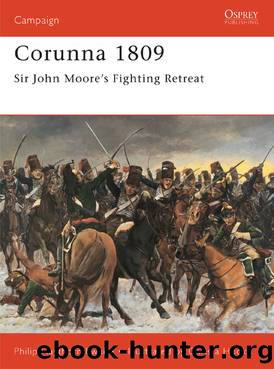Corunna 1809 by Philip Haythornthwaite

Author:Philip Haythornthwaite
Language: eng
Format: epub
Tags: Corunna 1809: Sir John Moore’s Fighting Retreat
ISBN: 9781472801982
Publisher: Osprey Publishing
The castle at Benavente, ransacked by the British on their retreat. (Print after Robert Ker Porter)
General Charles Lefebvre-Desnouettes (1773–1822), commander of the cavalry of the Imperial Guard engaged at Benavente. Taken prisoner during the action, in 1812 he broke his parole, escaped from Cheltenham where he was living, and rejoined Napoleon’s army.
For two days Paget’s cavalry was involved in running skirmishes with the French advance-guard, against considerable odds and with such success that Napoleon estimated their numbers to be about twice the 2,400 men who were actually present. On 26 December two French squadrons, evidently from the 15me Chasseurs à Cheval of Ney’s Corps, captured some men of the 15th Hussars at Mayorga, where the regimental baggage was preceding the retreat. The prisoners were liberated with the help of the 3rd KGL Hussars, but when Lord Paget arrived with the main body he found the French still in Mayorga. They fired at him through the gateway and then withdrew to higher ground. Paget ordered Slade to attack with a squadron of 10th Hussars, but that general hesitated so long (ostensibly to adjust his stirrups) that Paget instructed Colonel George Leigh of the 10th to lead instead. He led one squadron uphill (with another in support), through French carbine fire, halted to re-form, then charged, dispersed the chasseurs and took some 100 prisoners.
Craufurd’s Light Brigade covered the southernmost crossing of the Esla at Castro Gonzalo until the last elements of the army had passed. Two privates of the 43rd were posted as sentries, John Walton and Richard Jackson, to warn of the approach of the French advance-guard. When this appeared, as ordered Jackson ran back to raise the alarm, despite suffering 12 or 14 sabre cuts, while Walton defied the cavalry and actually beat them off, emerging unhurt despite having his clothing and equipment cut in more than 20 places, and his bayonet bent double and notched like a saw. Following their sharp reception, the French declined to engage, but Craufurd’s men stood in formation, with arms ported, in rain so torrential that Benjamin Harris of the 95th recalled that it actually flowed out of the muzzles of their rifles. Once Paget’s cavalry had crossed the river, two arches of the bridge were blown (with a ‘tremendous report’ according to Harris, which set fire to a nearby house).
Download
This site does not store any files on its server. We only index and link to content provided by other sites. Please contact the content providers to delete copyright contents if any and email us, we'll remove relevant links or contents immediately.
| Africa | Americas |
| Arctic & Antarctica | Asia |
| Australia & Oceania | Europe |
| Middle East | Russia |
| United States | World |
| Ancient Civilizations | Military |
| Historical Study & Educational Resources |
Life of Elizabeth I by Alison Weir(2026)
The Invisible Wall by Harry Bernstein(1762)
Art of Betrayal by Gordon Corera(1399)
1916 in 1966 by Mary E. Daly(1228)
Thunderstruck by Erik Larson(1181)
The Decline and Fall of the British Empire, 1781-1997 by Piers Brendon(1096)
A Brief History of Britain, 1066-1485 by Nicholas Vincent(1009)
A Brief History of Britain, 1485-1660 by Ronald Hutton(977)
Guy Burgess by Stewart Purvis(970)
Mary, Queen of Scots by Weir Alison(961)
Henry VIII by Alison Weir(909)
The Last Lion 02 - Winston Churchill - Alone, 1932-1940 by William Manchester(907)
Lang Lang by Lang Lang(833)
1066 by Andrew Bridgeford(829)
Gimson's Kings and Queens by Andrew Gimson(810)
The Last Plantagenet by Thomas B Costain(809)
Coalition by David Laws(806)
London: A Biography by Peter Ackroyd(801)
Diana by Andrew Morton(785)
